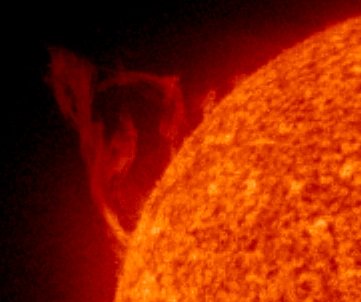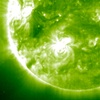Not-so-quiet Sunday
Saturday, April 25, 2009
The sun produced an unexpected burst of activity on April 23rd when an enormous Prominence rose on the northeastern limb and erupted. SOHO recorded the blast from beginning to end with a series of high-Cadence UV snapshots.

The complex explosion produced not one but two billion-ton coronal mass ejection (CMEs) movie.
An impact from such a double-CME would almost surely spark magnetic storms around the poles of Earth, but it is not heading in our direction. The chance of auroras remains low.
Ga to SpaceWeather.com -- News and information about meteor showers, solar flares, auroras, and near-Earth asteroids & auroras to-movie-viewing.
Translated version of http://www.star-people.nl/index.php?module=news&id=151
Saturday, April 25, 2009
The sun produced an unexpected burst of activity on April 23rd when an enormous Prominence rose on the northeastern limb and erupted. SOHO recorded the blast from beginning to end with a series of high-Cadence UV snapshots.

The complex explosion produced not one but two billion-ton coronal mass ejection (CMEs) movie.
An impact from such a double-CME would almost surely spark magnetic storms around the poles of Earth, but it is not heading in our direction. The chance of auroras remains low.
Ga to SpaceWeather.com -- News and information about meteor showers, solar flares, auroras, and near-Earth asteroids & auroras to-movie-viewing.
Translated version of http://www.star-people.nl/index.php?module=news&id=151

